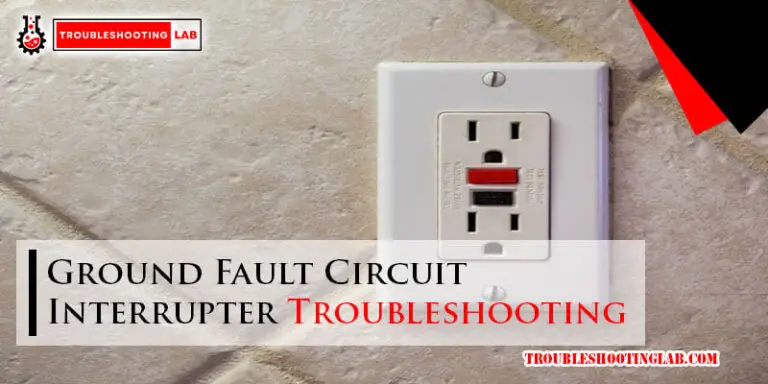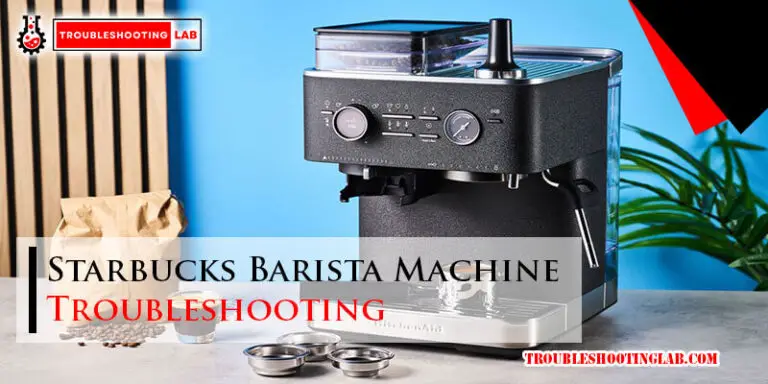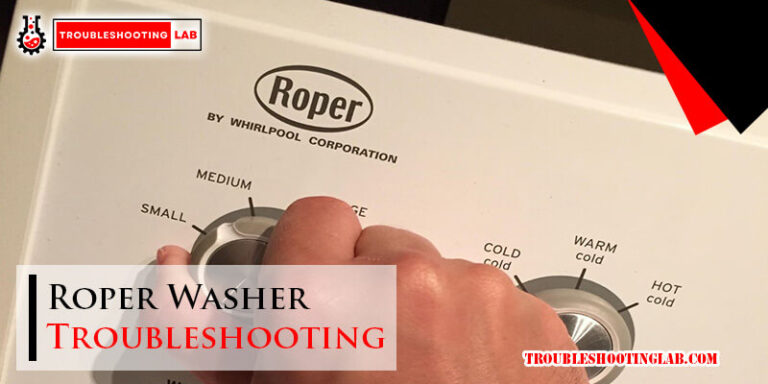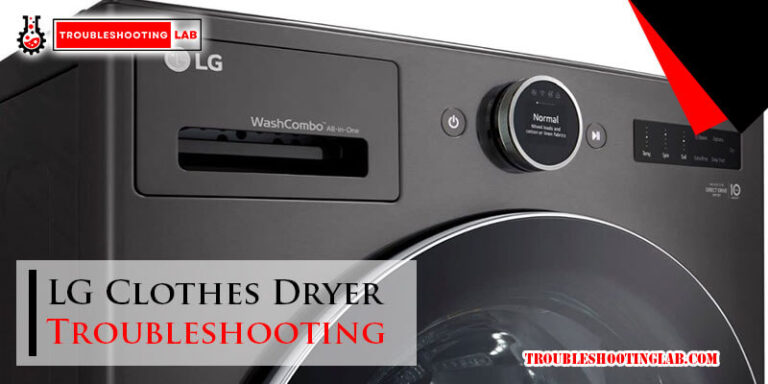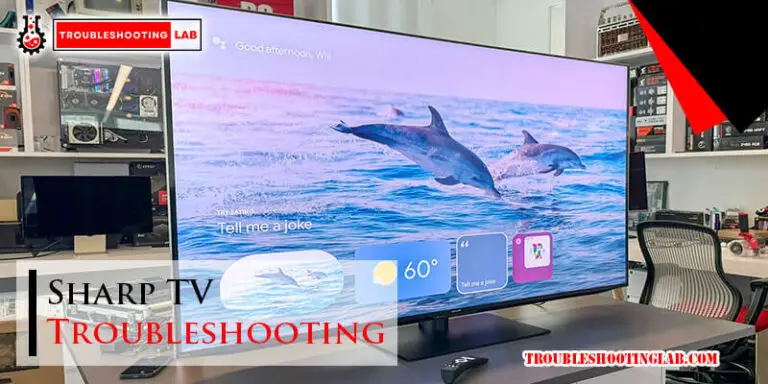Whirlpool Front Load Washer Troubleshooting: Fix Common Issues
To troubleshoot a Whirlpool front load washer, press and hold the “Start” and “Power” buttons simultaneously, then release the buttons and run a short cycle to check if the washer has been reset. One common problem with front load washers is the accumulation of mold around the rubber gasket on the door.
To reduce mold and mildew, it’s recommended to position the washer in an area with good airflow and leave the door slightly ajar between cycles. Leaks, odors, loud noises, and draining or spinning issues can also occur, with a dirty drain pump filter being a common cause.

Common Issues With Whirlpool Front Load Washers
Whirlpool front load washers are known for their efficiency and performance. However, like any other appliance, they can experience certain issues over time. Understanding these common problems can help you troubleshoot and resolve them effectively.
Mold Accumulation In Rubber Gasket
One of the most common issues with Whirlpool front load washers is the accumulation of mold in the rubber gasket. Over time, moisture and detergent residues can create the perfect environment for mold growth. Not only does this cause an unpleasant odor, but it can also affect the cleanliness of your laundry. To prevent this issue, it’s essential to regularly clean and dry the rubber gasket after each use. You can use a mixture of water and vinegar or a specialized washer cleaner to eliminate mold and keep your washer smelling fresh.
Leaks And Drainage Problems
Leaks and drainage problems can also occur with Whirlpool front load washers. These issues can be caused by a variety of factors, such as a clogged drain hose, faulty water inlet valve, or damaged door seal. If you notice water pooling around your washer or excessive vibration during the spin cycle, it’s important to inspect these components and replace them if necessary. Regularly checking the drain hose and cleaning it from debris can also help prevent clogging and ensure proper drainage.
Odors And Smells
Another common issue with Whirlpool front load washers is the development of unpleasant odors. These odors can be caused by a combination of factors, including mold accumulation, detergent residues, and stagnant water. To eliminate odors, it’s recommended to run a monthly cleaning cycle with hot water and bleach or a specialized washer cleaner. Additionally, leaving the washer door open after each use allows air to circulate and prevent the growth of bacteria and mold.
Loud Noises During Operation
Loud noises during operation can be quite alarming and disruptive. This issue can be caused by various factors, such as a loose drum, worn-out bearings, or a malfunctioning motor. Inspecting and tightening any loose components, lubricating the bearings, and replacing faulty parts can help resolve this issue. Regular maintenance and avoiding overloading the washer can also contribute to quieter and smoother operation.
Whirlpool Front Load Washer Error Codes
When it comes to troubleshooting your Whirlpool front load washer, understanding the error codes is essential. These error codes are displayed on the machine’s control panel and can help you identify the specific issue that your washer is facing. By knowing what each error code means, you can quickly diagnose the problem and take appropriate action to resolve it.
Understanding Error Codes
Whirlpool front load washers use error codes to communicate specific issues with the machine. These codes are displayed as alphanumeric combinations on the control panel. Each code represents a different problem, such as a water inlet issue, drain problem, or even a motor malfunction. By deciphering these error codes, you can pinpoint the exact cause of the problem and troubleshoot accordingly.
Diagnostic Mode Activation
To access the diagnostic mode on your Whirlpool front load washer, follow these steps:
- Make sure the washer is in standby mode and the power is on.
- Press and hold the “Start” and “Power” buttons simultaneously.
- Simultaneously press the “Start” or “Pause” (depending on your model) and “Cancel” or “Power” buttons.
- Release the buttons and wait for the diagnostic mode to activate.
Once in the diagnostic mode, you can navigate through various tests and error codes to troubleshoot the specific issue with your washer.
Error Code List
Here is a list of common error codes you may encounter on your Whirlpool front load washer:
| Error Code | Description |
|---|---|
| FH | Water Inlet Failure |
| FdL/FUL | Door Lock Failure |
| FP | Drain Pump Failure |
| LF | Long Fill |
These are just a few examples of the error codes you may come across. Each code indicates a specific problem area that requires attention and further troubleshooting.
Manual Parts Testing And Quick Test Cycle
In addition to error code diagnosis, Whirlpool front load washers also offer manual parts testing and a quick test cycle. These features allow you to test individual components of the washer, such as the door switch/lock assembly, control board, user interface control, and motor control board, among others. By conducting these tests, you can determine if any specific parts need to be replaced or repaired.
To initiate the manual parts testing and quick test cycle:
- Refer to your Whirlpool washer’s user manual for specific instructions.
- Follow the step-by-step guide to perform accurate tests on different parts of the machine.
- Take note of any abnormal readings or malfunctions during the tests.
By conducting these tests, you can troubleshoot individual components and identify any issues that may be affecting your washer’s performance.
In conclusion, understanding the error codes on your Whirlpool front load washer is crucial for effective troubleshooting. By activating the diagnostic mode, accessing the error code list, and conducting manual parts testing, you can diagnose the problem accurately and take the necessary steps to fix it.
Troubleshooting Specific Components
If you’re experiencing issues with your Whirlpool front load washer, it’s helpful to understand how to troubleshoot specific components. By identifying and addressing problems with the door switch/lock assembly, control board, user interface control, motor control board, and line filter, you can potentially resolve the issue and get your washer up and running again.
Door Switch/lock Assembly
The door switch/lock assembly is responsible for ensuring that the door is securely closed during operation. If the door switch or lock is faulty, it can result in the washer not starting or stopping mid-cycle. To troubleshoot this component:
- Check if the door is properly closed and latched.
- Inspect the door switch for any signs of damage or wear.
- Test the door switch with a multimeter to determine if it’s functioning correctly.
- If the door switch is faulty, it will need to be replaced.
Control Board
The control board is the brains of your washer, responsible for controlling various functions and settings. If the control board is malfunctioning, it can cause the washer to behave erratically or not function at all. To troubleshoot the control board:
- Check for any error codes displayed on the control panel.
- Unplug the washer and plug it back in to see if that resets the control board.
- If the issue persists, it may indicate a faulty control board that needs to be replaced.
User Interface Control
The user interface control allows you to select different cycles and settings on your washer. If the buttons are unresponsive or not functioning properly, it could indicate a problem with the user interface control. To troubleshoot this component:
- Check for any error codes displayed on the control panel.
- Clean the buttons and ensure they are not stuck or damaged.
- Disconnect and reconnect the wiring harness to the user interface control.
- If the issue persists, the user interface control may need to be replaced.
Motor Control Board
The motor control board is responsible for controlling the motor and other electrical components of the washer. If the washer is not spinning or agitating properly, it could indicate a problem with the motor control board. To troubleshoot this component:
- Check for any error codes displayed on the control panel.
- Inspect the motor control board for any signs of damage or burnt components.
- Test the motor control board with a multimeter to check for continuity.
- If the motor control board is defective, it will need to be replaced.
Line Filter
The line filter is responsible for filtering debris and sediment from the water supply to prevent clogs and damage to the washer. If the washer is not filling properly or experiencing low water pressure, it could indicate a problem with the line filter. To troubleshoot this component:
- Locate the line filter, typically located at the connection point between the water supply and the washer.
- Disconnect the water supply and inspect the filter for any clogs or debris.
- Clean the filter and reinstall it back into the washer.
- If the issue persists, it may be necessary to replace the line filter.
By troubleshooting these specific components, you can effectively diagnose and resolve common issues with your Whirlpool front load washer.
Simple Fixes For Common Problems
If you’re experiencing issues with your Whirlpool front load washer, don’t panic! Many common problems can be easily fixed without the need for a repair technician. In this section, we’ll explore some simple troubleshooting steps to help you get your washer back up and running smoothly.
Resetting A Whirlpool Front Load Washer
If your Whirlpool front load washer is not responding or acting up, a simple reset might do the trick. Follow these steps to reset your washer:
- Press and hold the “Start” and “Power” buttons simultaneously.
- While holding the buttons, also press the “Cancel” or “Power” button.
- Release all the buttons.
- Run a short cycle to check if the washer has been successfully reset.
By performing a reset, you can often resolve minor glitches and restore your washer’s functionality.
Improving Airflow And Preventing Mold
One of the most common problems with front load washers is the accumulation of mold and mildew. This issue usually arises due to the rubber gasket on the door trapping moisture and creating an ideal breeding ground for mold. To prevent this problem and improve airflow, follow these tips:
- Ensure that your washer is placed in an area with good airflow.
- Leave the washer door ajar between cycles to allow the interior to dry.
- Regularly wipe down the rubber gasket with a mild detergent to prevent mold growth.
By implementing these airflow and maintenance practices, you can minimize the chances of mold and enjoy a fresher-smelling washer.
Cleaning The Drain Pump Filter
If your Whirlpool front load washer is not draining properly, a clogged drain pump filter might be the culprit. To clean the drain pump filter, follow these steps:
- Locate the drain pump filter, usually found behind a small door or panel at the front bottom of your washer.
- Place a towel or container under the filter to catch any water that may spill out.
- Twist the filter counterclockwise to remove it.
- Inspect the filter for any debris or obstructions.
- Clean the filter under running water and remove any trapped debris.
- Reinstall the filter by twisting it back into place.
Regularly cleaning the drain pump filter can help prevent drainage issues and keep your washer running smoothly.
By following these simple troubleshooting steps, you can resolve common problems with your Whirlpool front load washer and save yourself the hassle and expense of a repair technician.
Tips For Diy Repairs And Maintenance
Regular maintenance and troubleshooting are essential for keeping your Whirlpool front load washer running smoothly. By understanding how to inspect and repair common issues, you can save time and money. Here are some useful tips for DIY repairs and maintenance to keep your washer in optimal condition.
Inspecting The Impeller
The impeller, also known as the drain pump filter, plays a crucial role in preventing clogs and maintaining proper drainage. Regular inspection of the impeller is necessary to ensure it is free from debris and any obstructions. Here’s how to inspect the impeller:
- Turn off the washer and unplug it from the power supply.
- Locate the impeller behind the front panel of the washer.
- Remove the filter cover and carefully inspect the impeller for any debris.
- If you find any obstructions, use a soft brush or cloth to clean the impeller.
- Once clean, reassemble the filter cover and ensure it is securely in place.
Checking Modular Connectors
Modular connectors are responsible for transmitting signals between different components of the washer. Checking these connectors regularly can help identify any loose or faulty connections. Follow these steps to check the modular connectors:
- Disconnect the power supply and remove the front panel of the washer.
- Locate the modular connectors, typically found near the control board.
- Inspect each connector, ensuring they are firmly attached and free from dirt or corrosion.
- If any connectors are loose, gently push them back into place until you hear a click.
- After checking and securing all the connectors, reassemble the front panel.
Starting And Re-assembly
Before starting the washer or reassembling any components, it’s essential to follow proper procedures to prevent damage. Here’s what you should do:
- Ensure all connections and parts are properly secured and reassembled according to the manufacturer’s instructions.
- Double-check that no spare tools or equipment are left inside the washer.
- Close the washer door securely.
- Plug the washer back into a grounded power outlet.
- Start the washer and run a short cycle to verify that it is functioning correctly.
Drain Inspection
Proper drainage is crucial for the efficient operation of your front load washer. Regularly checking the drain is essential to prevent any issues. Here’s how to inspect the drain:
- Turn off the washer and unplug it from the power supply.
- Locate the drain hose that connects to the back of the washer.
- Check the hose for any kinks, clogs, or obstructions.
- If you spot any issues, carefully remove the clog or straighten out the hose.
- Reconnect the drain hose securely to the washer.
Testing The Repair
After completing any repairs or maintenance tasks, it’s crucial to test the washer to ensure everything is functioning correctly. Follow these steps to test the repair:
- Plug the washer back into a grounded power outlet.
- Select a short cycle and start the washer.
- Observe the washer’s performance, including proper water filling, agitation, and draining.
- If everything is working correctly, the repair can be considered successful.
Regular maintenance and DIY repairs can extend the lifespan of your Whirlpool front load washer and help avoid costly repairs. Remember to consult your appliance’s manual and follow all safety guidelines provided by the manufacturer. However, if you are uncertain or uncomfortable with DIY repairs, it is always best to consult a professional technician.
Frequently Asked Questions Of Whirlpool Front Load Washer Troubleshooting
How Do You Reset A Whirlpool Front Load Washer?
To reset a Whirlpool front load washer, press and hold the “Start” or “Pause” button and the “Cancel” or “Power” button simultaneously. Release the buttons and run a short cycle to see if the washer has been reset.
What Is The Most Common Problem With Front Load Washer?
The most common problem with a front load washer is the smell or mold issue. Over time, mold can accumulate around the rubber gasket on the door. To prevent this, it’s recommended to position the washer in an area with good airflow and leave the door slightly ajar between cycles.
What Is Common Problem For Whirlpool Washer?
One common problem for Whirlpool washers is leaks, odors, loud noises, and trouble with draining or spinning. A dirty drain pump filter is often the cause, especially for front load washers. To fix these issues, clean the drain pump filter.
How To Put A Whirlpool Front Load Washer Into Diagnostic Mode?
To put a Whirlpool front load washer into diagnostic mode, press and hold the “Start” and “Power” buttons simultaneously. Then, press either “Start” or “Pause” (depending on your model), and “Cancel” or “Power” buttons at the same time. Release the buttons and run a short cycle to check if the washer has been reset.
How Do You Reset A Whirlpool Front Load Washer?
Press and Hold “Start” and “Power” Buttons. Release and run a short cycle to check the reset.
Conclusion
To troubleshoot your Whirlpool front load washer, follow the tips and steps mentioned in the blog post. By understanding common problems like leaks, odors, and issues with draining or spinning, you can effectively diagnose and solve any issues with your washer.
Don’t forget to check the rubber gasket for mold and mildew buildup, and keep the door slightly open between cycles for better airflow. With these troubleshooting techniques, you can keep your Whirlpool front load washer running smoothly for years to come.

